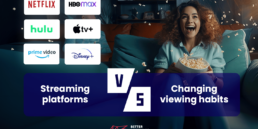In the first part of our review of various video monetization opportunities we mostly focused on the programmatic methods. YouTube ads, pay-per-view and independent advertising on demand platforms allow content creators to integrate a number of independent ad servers for increased flexibility and control.
But monetizing your high-quality video content can also be done through more direct, personal methods like product recommendations, directly partnering with sponsors or selling branded merchandise. Such approaches may not always scale easily, but they are often perceived as more credible and trustworthy than automated ads that roll before or after the video.
In this article, we take a closer look at some of these video monetization methods.
Affiliate Marketing
Affiliate marketing involves partnering with a brand that you love and supporting their products or services in your videos – and usually providing affiliate links in the video description. YouTube is particularly well suited to this kind of monetization because of its specific video genres – there are multiple formats to choose from: product reviews, how-to videos, comparison videos, unboxing videos, tutorials, or so-called “best of” videos showcasing the leading products in a given category.
Marques Brownlee – YouTube’s phone review prodigy with close to 9m subscribers – uses affiliate links as one of the ways to monetize his videos. He usually places the links (neatly shortened for clarity) in each video description.

Naturally, it’s worth to do the full disclosure and mention to your viewers that the links in the description come from the sponsor, and include a discount to further incentivize the clicks. Amazon (or any other shop) can attribute the link back to a particular video, and pay the youtuber based on the conversion rate.
In a typical review video, you can show how you use the product, why you love or hate it and share the typical use cases.
Sponsors
Brands are on the lookout for popular bloggers and YouTubers for various sponsorship opportunities. They’re typically looking for YouTubers that nicely align with their brand image, and would share and praise their products – either in return for money, or for the products themselves. This could involve casual placement of the products or regular mentioning them in videos.
Don’t expect Coca-Cola to reach out to you straight away. It’s your job to start pitching companies you love to negotiate nice sponsorship deals. Remember to align your message with the audience — if you have a fashion-focused channel, don’t try to force engine oil down your audience’s throats. Your viewers will quickly see through badly aligned sponsorships – this could, in turn, lead to a loss of credibility and trust of your audience. To always be on the safe side, only stick to the brands you really trust and promote products that are relevant to your viewers and that you really believe in.
Also, always be open and properly disclose whenever a brand becomes your partner. For Youtube, Google has published its paid product placement guidelines, updated December 5, 2018.
Merchandise
One of the most important things to remember about monetizing video content is that while the video itself may not necessarily produce big revenue, it can lead to offshoots and opportunities that may be incredibly lucrative. For example, by owning content that is extremely popular, you can consider developing a line of own, specially branded merchandise. This could include branded t-shirts, mugs, linen bags – virtually anything people would be willing to buy from you.
To make it easier for the creator, there are so-called drop-shipping companies which will take care of all the hassle connected with branding, packing and shipping the merchandise. Own merchandise is especially a good idea if your brand has a humorous twist to it.
Subscriptions
Subscription monetization, also known as SVOD (Subscription Video On Demand), involves customer paying regularly (monthly, yearly, etc) for the ongoing access to all existing video (or audio) content on a given platform. To offer such an opportunity to your audience, you need to use the services of a SVOD provider.
Some creators use a variation of the subscription model alongside their regular, free-to-watch content. For example – Patronite “sponsors” can be offered extra video content with behind the scenes footage or other exclusive material. It is estimated than more than a third of professional broadcasters monetize their content via subscription models.
Subscription monetization makes the most sense for regular, valuable content that is released to a tight schedule. It lends well for regular shows, news, sports, etc.
On the other hand, the growing popularity of video streaming services clearly shows that this model has its limits – after all, there is a limited number of streaming services a viewer can subscribe to. The ongoing proliferation of video streaming services could soon lead to saturation of the market and the so-called OTT fatigue.
When you add to this the popularity of various ad blockers it becomes clear that pay-per-view may soon be the only viable option for video monetization.
Conclusion
Video content is on the rise and it makes sense to get on the bandwagon to stay on top of your game.
- The annual growth rate in the OTT market is expected to exceed 30 percent.
- By 2024, 310 million households around the globe are expected to subscribe to at least one OTT service.
- OTT revenue is expected to reach $83.4 billion worldwide by 2022.
- Also by 2022, global OTT video spends will reach $559 billion.
- US subscribers to OTT services more than doubled between Q2 2017 and Q2 2018.
But whatever method you choose for monetizing your videos, you’ll need the technology to make it work. This involves partnering with an Online Video Platform – a service for hosting and delivering both Video On-Demand (VOD) and live video streams.
If you find this article valuable, you can share it on social media →
Read more about the VOD & OTT Industry!
March 7, 2024
7 reasons why is sports streaming becoming so popular
Learn more about the reasons why sports streaming is becoming more and more popular right now.
February 29, 2024
Why should streaming platforms adapt to changing viewing habits?
Discover the strategies through which streaming platforms adjust to changing viewing habits.
February 20, 2024
What is Titan OS and what do we know about it so far?
Explore what distinguishes Titan OS, a new smart TV operating system. Discover its unique features before giving it a try yourself.
Are you looking for a partner to build a Video Solution?
Leave your email and a short description about your project. We would gladly discuss different cooperation possibilities!





